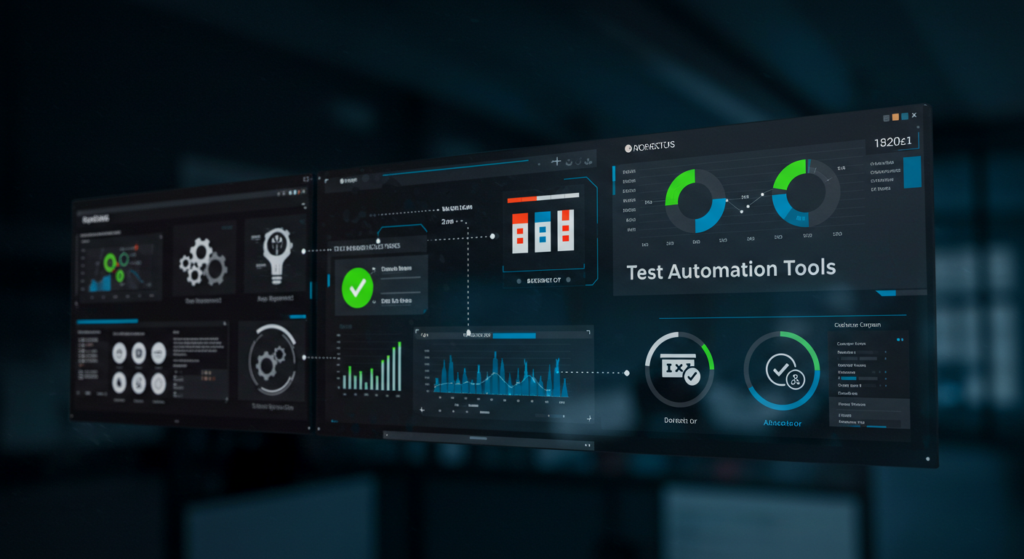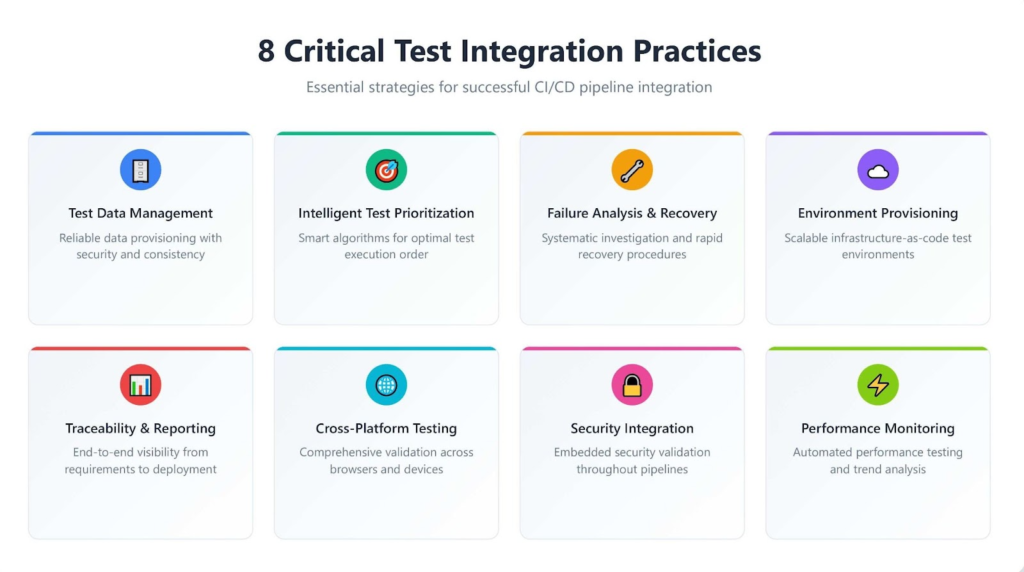Key Takeaways
Test management integration transforms CI/CD pipelines into quality-driven development engines that deliver faster, more reliable software releases.
- CI/CD tools usage correlates with better deployment performance across all DORA metrics for development teams with integrated testing practices
- Organizations with mature CI/CD testing see 63% faster deployment cycles while maintaining superior quality standards
- Unified test management platforms reduce tool complexity by 40% compared to fragmented testing approaches
- Teams using integrated test management report 50% fewer production defects due to comprehensive quality visibility metrics
The future belongs to organizations that seamlessly blend test management with CI/CD automation, creating unstoppable quality delivery machines.
The days of treating testing as an afterthought are over. Modern software development demands that test management integration becomes the backbone of your CI/CD pipeline, not just another step in the process. With 83% of developers now involved in DevOps practices and the DevOps market projected to reach $19.46 billion by 2030, the question isn't whether you need integrated testing—it's how quickly you can implement it effectively.
When test management and CI/CD testing work in harmony, something powerful happens. Your development team gains the confidence to deploy multiple times per day. Your DevOps QA processes become predictive rather than reactive. Your entire organization moves from firefighting production issues to preventing them altogether.
Understanding Test Management Integration in Modern DevOps
Test management integration represents the strategic alignment of testing processes, tools, and workflows within your CI/CD pipeline. Unlike traditional approaches where testing happens in isolated phases, integrated test management embeds quality assurance throughout the entire development lifecycle.
This integration encompasses everything from requirement traceability and test case management to automated execution and real-time reporting. When properly implemented, it creates a unified quality ecosystem where every code change triggers appropriate testing protocols, every test result provides actionable insights, and every deployment decision is data-driven.
The integration operates on multiple levels simultaneously. At the process level, it ensures testing activities align with development sprints and deployment schedules. At the tool level, it creates seamless data flow between version control, test execution, and deployment platforms. At the cultural level, it transforms testing from a gatekeeper role into a quality enabler that accelerates rather than slows development velocity.
The Evolution Beyond Traditional Testing Approaches
Traditional testing approaches created bottlenecks that modern development speeds simply cannot tolerate. Teams would complete development work, hand it off to QA for testing, wait for bug reports, fix issues, and repeat the cycle. This waterfall-style approach could stretch testing phases for weeks, creating dangerous disconnects between code changes and quality feedback.
Test management integration eliminates these delays by making testing concurrent with development. As developers write code, appropriate tests execute automatically. As features evolve, test coverage adapts dynamically. As deployments approach, comprehensive quality dashboards provide instant go/no-go decisions based on real-time data rather than delayed manual reports.
Strategic Foundations for CI/CD Testing Success
Establishing Quality Gates That Actually Work
Quality gates serve as your pipeline's immune system, automatically blocking problematic code from advancing to production. However, effective quality gates require careful calibration between thoroughness and speed. The key lies in implementing progressive quality checks that become more comprehensive as code moves through your pipeline stages.
Early-stage quality gates should focus on fast, high-confidence tests like unit tests and static code analysis. These provide immediate feedback to developers while consuming minimal pipeline resources. Mid-stage gates can include integration tests and security scans that validate component interactions. Final gates should encompass end-to-end testing and performance validation that ensures production readiness.
The most successful teams configure their quality gates with both mandatory and advisory thresholds. Mandatory thresholds block deployment when critical issues are detected, while advisory thresholds provide warnings that help teams make informed decisions about acceptable risk levels for specific releases.
Creating Comprehensive Test Coverage Strategies
Effective CI/CD testing follows the testing pyramid principle, but with modern adaptations that account for microservices, cloud infrastructure, and continuous deployment realities. Your test coverage strategy should prioritize speed and reliability while maintaining comprehensive quality validation.
Start with a robust foundation of unit tests that validate individual components rapidly and reliably. These tests should run in seconds, not minutes, and catch the majority of basic functionality issues. Build upon this foundation with targeted integration tests that validate critical system interactions without testing every possible combination.
Top-level end-to-end tests should focus on core user journeys and business-critical workflows rather than attempting comprehensive scenario coverage. This approach provides confidence in system behavior while maintaining the speed necessary for continuous deployment. Remember that perfect test coverage is less valuable than fast, reliable feedback that enables rapid iteration and improvement through effective test plans that guide your testing strategy.
Technical Implementation Best Practices
Designing Pipeline Architecture for Testing Excellence
Your CI/CD pipeline architecture directly impacts testing effectiveness and development velocity. The best architectures separate testing concerns by speed and scope, allowing different test types to run in parallel when possible while maintaining logical dependencies between stages.
Consider implementing a multi-stage approach where fast tests run first to provide immediate feedback, followed by more comprehensive tests that can run in parallel with subsequent development work. This approach maximizes resource utilization while minimizing feedback delays that can interrupt developer flow states.
Pipeline architecture should also account for failure scenarios and recovery procedures. When tests fail, your pipeline should provide clear diagnostic information, easy re-run capabilities, and intelligent retry logic that distinguishes between genuine failures and transient infrastructure issues.
Tool Selection and Integration Strategies
The tool landscape for CI/CD testing continues expanding rapidly, making selection decisions increasingly complex. Rather than choosing tools based on features alone, focus on integration capabilities, maintenance overhead, and team expertise requirements.
Look for tools that provide native integrations with your existing development infrastructure rather than requiring custom bridge solutions. Native integrations reduce maintenance overhead and provide more reliable data flow between systems.
Tools like TestQuality, with their native integrations for platforms such as GitHub and Jira, exemplify this streamlined approach, eliminating complex custom configurations while providing comprehensive test planning and execution capabilities.

Consider the total cost of ownership beyond initial licensing fees. Factor in training requirements, ongoing maintenance, infrastructure costs, and the opportunity cost of team time spent managing tools rather than improving product quality. Sometimes a slightly more expensive tool that requires less manual management provides better overall value.
When evaluating platforms, ensure they support both automated pipeline testing and manual validation approaches like exploratory testing that complement your CI/CD automation strategy.
Automation Strategies That Scale
Test automation in CI/CD pipelines requires different thinking than traditional automation approaches. Pipeline automation must prioritize reliability and speed over comprehensive coverage, since pipeline failures can block entire development teams rather than just individual testers.
Focus on automating tests that are executed frequently, have clear pass/fail criteria, and provide high confidence in system quality. Tests that require significant maintenance, produce frequent false positives, or depend on external systems that aren't always available may be better suited for separate validation processes rather than pipeline gates.
Implement robust retry logic and error handling in your automated tests to account for the distributed, ephemeral nature of CI/CD environments. Tests that work perfectly in local development environments may encounter network latencies, resource contention, or timing issues in pipeline execution contexts.
Essential Best Practices for Seamless Integration
Start Small and Scale Systematically
The most successful test management integration projects begin with pilot implementations on single teams or applications before expanding organization-wide. This approach allows you to validate your integration strategy, identify potential issues, and refine processes before affecting larger development efforts.
Choose your pilot projects carefully, selecting applications that are actively developed, have motivated team members, and represent typical complexity for your organization. Avoid starting with either your most critical production systems or your simplest legacy applications, as neither will provide representative learning experiences.
Document lessons learned during pilot implementations and create repeatable processes for expanding integration to additional teams. This documentation becomes invaluable for scaling efforts and helps avoid repeating mistakes across multiple implementation cycles.
Optimize Test Execution for Pipeline Performance
Pipeline performance directly impacts developer productivity and team morale. Slow pipelines encourage developers to batch changes, reducing the feedback frequency that makes CI/CD valuable. Fast pipelines enable rapid iteration and continuous improvement cycles that drive innovation.
Implement intelligent test selection that runs only tests affected by specific code changes when possible. This approach reduces pipeline execution time while maintaining quality coverage for changed functionality. Full test suites can run periodically or triggered by specific events like release preparations.
Leverage parallel execution capabilities to run independent tests simultaneously rather than sequentially. Modern CI/CD platforms provide sophisticated parallel execution options that can dramatically reduce total pipeline time when configured appropriately.
Implement Comprehensive Monitoring and Observability
Effective test management integration requires visibility into both testing processes and their impact on development velocity. Implement monitoring that tracks test execution times, failure rates, and resolution cycles to identify optimization opportunities.
Monitor not just test results, but also pipeline health metrics like queue times, resource utilization, and success rates. These operational metrics often reveal bottlenecks that aren't obvious from test results alone but significantly impact team productivity.
Create dashboards that provide different views for different stakeholders. Developers need immediate feedback on their specific changes, while managers need trend analysis that shows quality improvement over time. QA teams need detailed failure analysis that helps them improve test effectiveness.
Advanced Integration Patterns and Strategies
Progressive Quality Assurance Models
Advanced organizations implement progressive quality models that adjust testing rigor based on change risk, release timing, and business priorities. This approach provides flexibility while maintaining quality standards appropriate for different deployment scenarios.
Low-risk changes like configuration updates or documentation modifications can proceed through abbreviated testing pipelines, while high-risk changes like core algorithm modifications trigger comprehensive validation suites. The key is defining clear criteria for risk assessment and ensuring consistent application across teams.
Progressive models also account for release timing, applying more stringent testing for releases scheduled during high-traffic periods or business-critical timeframes. This approach balances the need for continuous deployment with business risk management requirements.
Cross-Team Collaboration and Communication Frameworks
Test management integration success depends heavily on effective collaboration between development, QA, and operations teams. Establish clear communication protocols that ensure testing feedback reaches the right people at the right time with appropriate context and priority information.
Implement shared vocabulary and documentation standards that enable effective communication across team boundaries. When developers, testers, and operations staff use consistent terminology and follow similar documentation practices, collaboration becomes more efficient and less error-prone.
Create regular review cycles where teams can discuss testing effectiveness, identify improvement opportunities, and align on quality standards. These reviews should focus on process improvement rather than blame assignment, encouraging open communication about challenges and solutions.
8 Critical Integration Practices Every Team Should Implement
Successful test management integration requires disciplined execution of proven practices that have demonstrated effectiveness across diverse development environments:

Establish Clear Test Data Management Strategies - Implement consistent test data provisioning that ensures tests have reliable, representative data while protecting sensitive information through appropriate masking and anonymization techniques.
Create Intelligent Test Prioritization Systems - Develop algorithms that prioritize test execution based on code change analysis, historical failure patterns, and business risk assessment to maximize quality coverage within pipeline time constraints.
Implement Robust Failure Analysis and Recovery Procedures - Design systematic approaches for investigating test failures, distinguishing between genuine issues and environmental problems, and recovering quickly from both types of failures.
Design Scalable Test Environment Provisioning - Create infrastructure-as-code solutions that can rapidly provision consistent test environments, ensuring tests run in reliable conditions that mirror production characteristics.
Establish Comprehensive Traceability and Reporting Systems - Implement tracking that connects requirements to test cases to results to deployments, providing complete visibility into quality coverage and enabling rapid impact analysis.
Create Cross-Browser and Cross-Platform Testing Strategies - Develop systematic approaches for validating functionality across different browsers, devices, and operating systems without creating pipeline bottlenecks.
Implement Security Testing Integration - Embed security validation throughout your pipeline rather than treating it as a separate concern, ensuring security issues are identified and addressed as quickly as functional defects.
Design Performance Testing and Monitoring Integration - Create automated performance validation that can detect regressions quickly while providing trending data that helps optimize application performance over time.
Measuring Success and Continuous Improvement
Key Performance Indicators for Integration Success
Effective measurement requires tracking both leading and lagging indicators that provide insights into integration effectiveness and areas for improvement. Leading indicators help predict future success, while lagging indicators confirm whether your integration efforts are achieving desired outcomes.
Track deployment frequency, lead time for changes, mean time to recovery, and change failure rate as core DORA metrics that indicate overall DevOps effectiveness. These metrics provide valuable context for evaluating test management integration impact on organizational performance.
Monitor test-specific metrics like test execution time trends, test maintenance effort, false positive rates, and defect escape rates to evaluate testing process effectiveness. These metrics help identify optimization opportunities and validate improvement initiatives.

Establishing Feedback Loops for Continuous Enhancement
Create systematic feedback collection from all stakeholders affected by test management integration, including developers, testers, operations staff, and business stakeholders. Different groups will have different perspectives on integration effectiveness and improvement priorities.
Implement regular retrospectives focused specifically on testing integration effectiveness rather than general development processes. These focused discussions often reveal insights that broader retrospectives might miss while providing dedicated time for testing improvement initiatives.
Use data-driven approaches to identify improvement opportunities rather than relying solely on subjective feedback. Combine quantitative metrics with qualitative insights to develop comprehensive understanding of integration strengths and weaknesses.
Overcoming Common Integration Challenges
Addressing Tool Complexity and Integration Overhead
Modern development environments often involve dozens of specialized tools, creating integration complexity that can overwhelm teams and reduce productivity. The key to managing this complexity lies in choosing integration approaches that reduce rather than increase operational overhead.
This is where unified test management platforms prove invaluable. For instance, solutions like TestQuality are designed to integrate natively with popular development tools such as GitHub and Jira. This approach eliminates the need for complex custom integrations, reducing maintenance overhead while providing comprehensive test planning and execution capabilities within a single environment.
Focus on consolidating tools where possible rather than adding specialized solutions for every specific need. A smaller number of well-integrated tools often provides better overall functionality than a larger collection of point solutions that require custom integration work.
Managing Cultural and Organizational Resistance
Test management integration often requires significant changes to established workflows and team responsibilities, creating natural resistance that must be addressed through change management rather than technical solutions alone. Success requires addressing both rational concerns and emotional reactions to change.
Provide clear communication about integration benefits that matter to different stakeholder groups. Developers care about faster feedback and reduced context switching. Managers care about improved predictability and reduced production issues. Operations teams care about deployment reliability and incident reduction.
Implement changes gradually with clear success metrics that demonstrate value at each stage. Early wins build momentum and credibility that makes subsequent changes easier to implement and adopt.
Solving Resource and Budget Constraints
Test management integration requires initial investment in tools, training, and process development that may strain constrained budgets. However, the cost of not implementing effective integration often exceeds implementation costs through production issues, delayed releases, and team inefficiency.
Develop business cases that quantify both implementation costs and expected benefits in terms that matter to budget decision-makers. Focus on measurable impacts like reduced production incident costs, faster time-to-market, and improved development team productivity.
Consider phased implementation approaches that spread costs over time while delivering incremental value. This approach makes budget approval easier while providing opportunities to validate ROI before making larger investments.
Future-Proofing Your Integration Strategy
Adapting to Emerging Technologies and Methodologies
The software development landscape continues evolving rapidly, with new technologies, methodologies, and tools emerging constantly. Successful integration strategies must be designed for adaptability rather than optimized for current-state requirements alone.
Build integration architectures that can accommodate new tools and technologies without requiring complete redesign. This typically means favoring open standards, API-first approaches, and modular designs that can evolve incrementally rather than requiring wholesale replacement.
Stay informed about emerging trends like AI-powered testing, shift-left security practices, and cloud-native development approaches that may impact your integration strategy. Early awareness enables proactive adaptation rather than reactive scrambling when new approaches become mainstream.
Scaling Integration Across Growing Organizations
As organizations grow, test management integration must scale to accommodate larger teams, more complex applications, and diverse technology stacks without losing effectiveness or becoming unmanageably complex.
Design integration patterns that can be replicated across teams while allowing for reasonable customization based on specific team needs and technology requirements. Standardization enables scaling, but excessive rigidity can reduce adoption and effectiveness.
Invest in automation and self-service capabilities that reduce the administrative overhead of managing integration across multiple teams. Teams should be able to onboard new applications and modify integration configurations without requiring specialized expertise or central coordination.
Choosing the Right Test Management Platform
When evaluating test management platforms for CI/CD integration, prioritize solutions that offer native integrations with your existing development infrastructure rather than requiring extensive custom development work. The best platforms seamlessly connect with version control systems, issue trackers, and deployment tools while providing comprehensive test planning and execution capabilities.
For organizations serious about DevOps transformation, effective testing integration requires platforms that offer native connectivity with popular development tools like GitHub and Jira. Solutions like TestQuality exemplify this approach, enabling teams to maintain their existing workflows while gaining comprehensive test management capabilities.
Look for platforms that support both manual and automated testing within unified workflows, enabling teams to leverage the strengths of each approach without creating artificial barriers between testing methods. The most effective solutions provide comprehensive test planning, execution tracking, and results analysis in a single integrated environment.
Frequently Asked Questions
How long does it typically take to implement test management integration with CI/CD?
Implementation timelines vary significantly based on organization size and complexity, but most teams see initial value within 4-6 weeks with a pilot project. Full organizational rollout typically takes 3-6 months with proper planning and change management. The key is starting small with high-value use cases and expanding systematically.
What's the biggest mistake teams make when integrating test management with CI/CD?
The most common mistake is trying to automate everything immediately rather than focusing on high-value tests that provide reliable feedback quickly. Teams often spend months automating complex end-to-end scenarios that break frequently, instead of building solid foundations with fast, reliable unit and integration tests that enable rapid iteration.
How do we measure ROI from test management integration investments?
Focus on measurable improvements in deployment frequency, lead time for changes, and change failure rates as primary ROI indicators. Also track time savings from reduced manual testing overhead, decreased production incident costs, and improved developer productivity from faster feedback cycles. Most organizations see positive ROI within 6 months of effective implementation.
Should we build custom integrations or use existing platforms?
Unless you have very specific requirements that no existing platform can meet, using established platforms provides better long-term value. Building custom integrations requires ongoing maintenance and limits your ability to adopt new tools and technologies. Platforms like TestQuality provide extensive integration capabilities while reducing maintenance overhead.
Final Thoughts: Accelerate Your Quality Delivery Today
Test management integration with CI/CD isn't just a technical upgrade—it's a competitive advantage that enables organizations to deliver higher quality software faster than ever before. The teams that master this integration will define the future of software development, while those that delay will find themselves struggling to keep pace with market demands.
The path forward is clear: start with strategic planning, implement systematically, measure relentlessly, and iterate continuously. Your development teams are ready for the speed and reliability that effective integration provides. Your customers expect the quality that comprehensive testing delivers.
Ready to transform your CI/CD pipeline into a quality-driven development engine? Start your TestQuality trial today and experience how seamless test management integration can accelerate your delivery velocity while elevating your quality standards.





